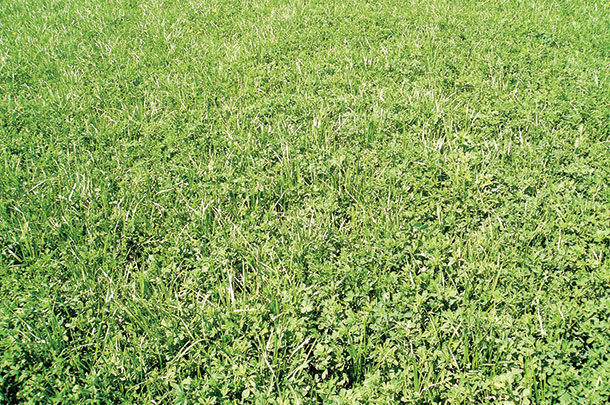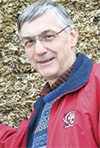they change their tune (based on new and relevant research, of course) and tell farmers to move in a different, sometimes opposite, direction – and a “re-education” program is now needed.
A good example of this is the recommendation for choosing a cool-season forage grass species to seed with alfalfa. While pure alfalfa is preferred where alfalfa is irrigated – including the southwestern U.S., much of the Corn Belt and most alfalfa in the northeastern U.S. – an increasing amount in the upper Midwest is seeded with a cool-season forage grass.
But which species of grass should farmers use? Over the years, farmers have tried and eventually rejected several grass species via something we might call the “Goldilocks syndrome.”
This syndrome plays out when one species (orchardgrass or some ryegrass varieties) is “too hot” – too competitive to the alfalfa early and late in the season – while another grass (timothy) is “too cold” because it often goes dormant after first harvest, contributing little to the yield of second and subsequent harvests. There’s a reason these species are called “cool-season” grasses.
One of the first articles I had published in a national farm magazine (1977) extolled the virtues of low-alkaloid reed canarygrass. Soon after becoming agronomist at the William H. Miner Agricultural Research Institute (Chazy, New York) in 1981, we started seeding Palaton reed canarygrass, both in clear stands and with either Ladino clover or alfalfa.
Canarygrass seed is expensive and the seedlings are slow to establish, but once the stand is there, it’s there to stay.
The root system is so rugged that an established crop will support field equipment even when the soil is so wet the water literally runs off the tractor tires. There might be something other than herbicides that will kill reed canarygrass, but if there is I don’t know of it.
Armyworms love the broad leaves of canarygrass, but even an infestation of these voracious insects won’t kill it. Some reed canarygrass at Miner Institute is now more than 25 years old and going strong.
Our love affair with reed canarygrass faded, however, when Cornell University forage variety trials found that the quality of this species wasn’t nearly as good as that of endophyte-free tall fescue.
One of the endophytes found in tall fescue produces an alkaloid that can harm livestock. Almost all tall fescue varieties sold where alfalfa-grass is commonly grown should be endophyte-free, but it still pays to confirm this with your dealer.
Spring and summer yields of tall fescue are comparable to reed canarygrass, but while canarygrass goes dormant and turns an unsightly orange with the first autumn cold snap, tall fescue continues to grow aggressively into the fall. Tall fescue seed costs less than half as much as reed canarygrass seed, and establishment is much easier.
While Cornell University currently tests about two dozen tall fescue varieties, canarygrass has fallen out of favor to the extent that it’s not even included in its annual forage variety testing program. Yield trials are finding that there isn’t much difference in yield among tall fescue varieties – even the newer ones – and most of the tall fescue varieties Cornell University tests head out within a few days of each other.
With endophyte-free tall fescue, farmers now had a cool-season grass species with excellent seed availability, reasonable seed cost, an agreeable companion with alfalfa in alfalfa-grass stands and good forage quality.
What could be better? Perhaps a grass species that has even higher quality than tall fescue and higher yields in mixed stands would be better – but what is it?
That grass may be meadow fescue; the word “may” is emphasized because we don’t have enough experience with alfalfa-meadow fescue to be sure, but so far both farmer experience and university trials are encouraging.
In a central New York alfalfa-grass trial, the percentage of neutral detergent fiber of seeding-year meadow fescue and tall fescue in the mixtures were very similar for all three harvests, but 48-hour neutral detergent fiber digestibility of meadow fescue was 4 to 6 percentage points higher.
Limited farmer experience (observation, no data) in New York suggests meadow fescue may not yield quite as much as tall fescue in pure stands but yields are higher in mixed (alfalfa-grass) stands.
Meadow fescue plants contain an endophyte, but this one has no negative impact on animal performance; in fact, it produces an alkaloid (loline) that protects the plant from drought and heat.
If there’s a downside to meadow fescue, it’s seed price. At almost $4 per pound, the seed costs about twice as much as that of tall fescue. However, at the recommended seeding rate of 4 pounds per acre (for both fescue species), and since most alfalfa-grass stands are maintained for several years, the annual difference amounts to only a couple of dollars per acre.
Alfalfa-grass facts of life
Farmers who have never seeded grass with their alfalfa should keep two facts in mind when managing alfalfa-grass.
First, alfalfa-grass should be seeded only where soil-test potassium (K) levels are high or at least medium-high. That’s because established grasses – and meadow fescue is no exception – have fine-textured root systems remarkably efficient at finding and removing K from the soil.
So efficient, in fact, that in low-K soils the grasses in an alfalfa-grass stand can take up enough K to have normal plant K concentration while the alfalfa winterkills from K deficiency. (K is antifreeze for alfalfa.)
Unfortunately, I have firsthand experience with this problem: One spring, we seeded alfalfa-grass in a low-K field at Miner Institute, thinking that by using plenty of K in the fertilizer band and then top-dressing the stand with 0-0-60 later that summer, we’d avoid any nutrient problems.
The alfalfa looked fine heading into winter, but by the following spring, there was little alfalfa but a good stand of grass.
A soil analysis found that the soil-test K recommendation was zero pounds per acre – the first time the director of the soil test lab said she’d ever encountered a zero reading. Yet that summer, when we did a forage analysis on the grass in that field, the K concentration was 2.65 percent, which is spot-on normal for grass.
Second, while the nutrients for the next harvest of alfalfa are stored in the taproot, grasses store these nutrients in the bottom few inches of the stems. Therefore, if alfalfa-grass is mowed too closely – 2-inch stubble height is fine for alfalfa but not for forage grasses – this will remove some of the nutrients the grass needs for regrowth.
The alfalfa will survive, but the grass will recover very slowly and in some extreme cases (particularly with new seedings) may even die.
This isn’t simply a theoretical concept: In a greenhouse trial at Miner Institute, first-year reed canarygrass cut at 2-inch stubble height died while that cut at 4-inch stubble height re-grew normally.
And in side-by-side fields of orchardgrass in Virginia, both fields were managed similarly, except one field was cut at a 2-inch stubble height and the other at 4 inches. Each time the grass was cut at a 4-inch stubble height, the re-grow was much faster. The minimum stubble height for alfalfa-grass should be 3 inches, and 4 inches is better. ![]()
PHOTO: This second-year, alfalfa-tall fescue mix at Miner Institute shows a nice mix of the two species growing in a moderately well-drained field. The seeding mixture was 12 pounds of alfalfa and 4 pounds of tall fescue. Photo by Everett Thomas.

-
Everett D. Thomas
- Oak Point Agronomics Ltd.
- Email Everett D. Thomas










